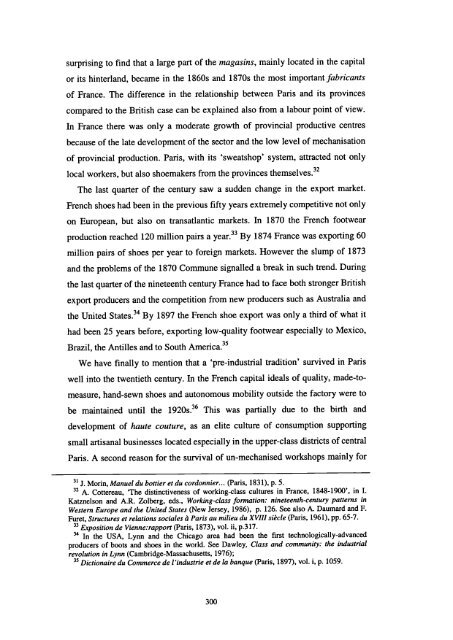The Boot and Shoe Trades in London and Paris in the Long Eighteenth Century
The Boot and Shoe Trades in London and Paris in the Long Eighteenth Century
The Boot and Shoe Trades in London and Paris in the Long Eighteenth Century
You also want an ePaper? Increase the reach of your titles
YUMPU automatically turns print PDFs into web optimized ePapers that Google loves.
surpris<strong>in</strong>g to f<strong>in</strong>d that a large part of <strong>the</strong> magas<strong>in</strong>s, ma<strong>in</strong>ly located <strong>in</strong> <strong>the</strong> capital<br />
or its h<strong>in</strong>terl<strong>and</strong>, became <strong>in</strong> <strong>the</strong> 1860s <strong>and</strong> 1870s <strong>the</strong> most important fabricants<br />
of France. <strong>The</strong> difference <strong>in</strong> <strong>the</strong> relationship between <strong>Paris</strong> <strong>and</strong> its prov<strong>in</strong>ces<br />
compared to <strong>the</strong> British case can be expla<strong>in</strong>ed also from a labour po<strong>in</strong>t of view.<br />
In France <strong>the</strong>re was only a moderate growth of prov<strong>in</strong>cial productive centres<br />
because of <strong>the</strong> late development of <strong>the</strong> sector <strong>and</strong> <strong>the</strong> low level of mechanisation<br />
of prov<strong>in</strong>cial production. <strong>Paris</strong>, with its 'sweatshop' system, attracted not only<br />
local workers, but also shoemakers from <strong>the</strong> prov<strong>in</strong>ces <strong>the</strong>mselves.32<br />
<strong>The</strong> last quarter of <strong>the</strong> century saw a sudden change <strong>in</strong> <strong>the</strong> export market.<br />
French shoes had been <strong>in</strong> <strong>the</strong> previous fifty years extremely competitive not only<br />
on European, but also on transatlantic markets. In 1870 <strong>the</strong> French footwear<br />
production reached 120 million pairs a year. 33 By 1874 France was export<strong>in</strong>g 60<br />
million pairs of shoes per year to foreign markets. However <strong>the</strong> slump of 1873<br />
<strong>and</strong> <strong>the</strong> problems of <strong>the</strong> 1870 Commune signalled a break <strong>in</strong> such trend. Dur<strong>in</strong>g<br />
<strong>the</strong> last quarter of <strong>the</strong> n<strong>in</strong>eteenth century France had to face both stronger British<br />
export producers <strong>and</strong> <strong>the</strong> competition from new producers such as Australia <strong>and</strong><br />
<strong>the</strong> United States. 34 By 1897 <strong>the</strong> French shoe export was only a third of what it<br />
had been 25 years before, export<strong>in</strong>g low-quality footwear especially to Mexico,<br />
Brazil, <strong>the</strong> Antilles <strong>and</strong> to South America.35<br />
We have f<strong>in</strong>ally to mention that a 'pre-<strong>in</strong>dustrial tradition' survived <strong>in</strong> <strong>Paris</strong><br />
well <strong>in</strong>to <strong>the</strong> twentieth century. In <strong>the</strong> French capital ideals of quality, made-to-<br />
measure, h<strong>and</strong>-sewn shoes <strong>and</strong> autonomous mobility outside <strong>the</strong> factory were to<br />
be ma<strong>in</strong>ta<strong>in</strong>ed until <strong>the</strong> 1920s. 36 This was partially due to <strong>the</strong> birth <strong>and</strong><br />
development of haute couture, as an elite culture of consumption support<strong>in</strong>g<br />
small artisanal bus<strong>in</strong>esses located especially <strong>in</strong> <strong>the</strong> upper-class districts of central<br />
<strong>Paris</strong>. A second reason for <strong>the</strong> survival of un-mechanised workshops ma<strong>in</strong>ly for<br />
M j • Mor<strong>in</strong>, Manuel du bottier et du cordonnier... (<strong>Paris</strong>, 1831), p. 5.<br />
32 A. Cottereau, '<strong>The</strong> dist<strong>in</strong>ctiveness of work<strong>in</strong>g-class cultures <strong>in</strong> France, 1848-1900', <strong>in</strong> I.<br />
Katznelson <strong>and</strong> A.R. Zolberg, eds., Work<strong>in</strong>g-class formation: n<strong>in</strong>eteenth-century patterns <strong>in</strong><br />
Western Europe <strong>and</strong> <strong>the</strong> United States (New Jersey, 1986), p. 126. See also A. Daumard <strong>and</strong> F.<br />
Furet, Structures et relations sociales a <strong>Paris</strong> au milieu du XVIII siècle (<strong>Paris</strong>, 1961), pp. 65-7.<br />
Exposition de Vienne:rapport (<strong>Paris</strong>, 1873), vol. ii, p.3 17.<br />
In <strong>the</strong> USA, Lynn <strong>and</strong> <strong>the</strong> Chicago area had been <strong>the</strong> first technologically-advanced<br />
producers of boots <strong>and</strong> shoes <strong>in</strong> <strong>the</strong> world. See Dawley, Class <strong>and</strong> community: <strong>the</strong> <strong>in</strong>dustrial<br />
revolution <strong>in</strong> Lynn (Cambridge-Massachusetts, 1976);<br />
Dictionaire du Commerce de l'<strong>in</strong>dustrie et de la banque (<strong>Paris</strong>, 1897), vol. i, p. 1059.<br />
300


